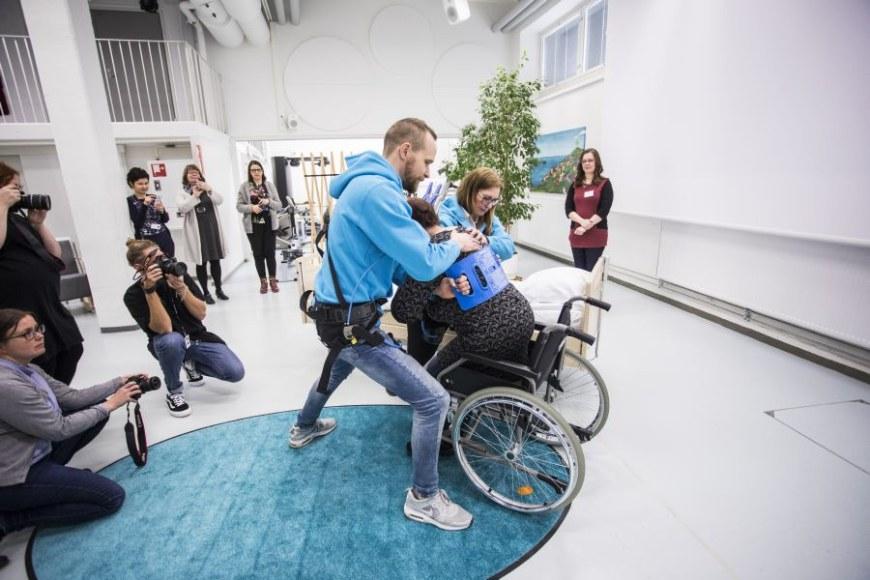Roadmap on care robots sets the direction for technology development

The choices in robotics and other technological developments play an important role in ensuring that the ageing population continues to receive high-quality, ethical, and affordable care. The Robots and the Future of Welfare Services – A Finnish Roadmap is based on the work of the six-year ROSE research consortium. The working group estimates that service robotics will be a more significant part of care work in ten years’ time.
At Tampere University, the fields of social sciences and philosophy participated in the multidisciplinary research consortium funded by the Strategic Research Council of the Academy of Finland. The ROSE consortium investigated the potential of a new generation of service robots in old people’s care services, with numerous experiments in home care, nursing homes, hospitals, and educational institutions. The study was based on the needs of older people, care professionals and organisations.
The researchers envisioned technological opportunities in the care services for older people. The roadmap supports the widespread use of robotics in a thoughtful and socially and ethically sustainable manner.
Interaction is a challenge in the use of assistive technology
One of the main lines of research was to seek solutions to support carers’ occupational well-being. Care workers hope that new technology will facilitate physically demanding tasks. The ROSE project tested, among other things, remotely controlled robots, hospitals’ logistics robots, and exoskeletons worn by care professionals.
The study showed that exoskeletons require further development to make wearable technology suitable for the services of old people.
Researcher Tuuli Turja explains how the exoskeleton experiment highlighted specifically the challenges of technology-mediated interaction in a people-oriented industry.
“When a nurse wore an exoskeleton, she feared that the robotic appearance would compromise the delicate and sensitive interaction between herself and the patient,” Turja says.
When a nurse cannot get to a client’s home, a videophone connection with a tablet device is already an established practice. A remotely controlled robot further extends the encounter, providing a better overview of the situation. It allows the nurse to move around and see the conditions in the home.

Even though the study highlighted positive experiences about technology development, the researchers argue that service robotics has not yet reached the technical level where it can be applied on a large scale to the care services of older people. Either the robot’s technology was found to have shortcomings, or the role of the technical solution was not very big. The existing applications proved to be very limited in scope.
“For example, interactive robots, such as Pepper in reception areas, are mainly a curiosity. They are still a long way from fulfilling the expectation that robots will replace person-years,” Turja explains.
Towards responsible and sustainable service technologies
The roadmap points out that organisations need to be supported to embrace new technologies. Training is also key, and the researchers recommend that technology skills should be part of the care sector at all levels. Both care staff and older people should be involved in technology by sharing their experiences.
“Training and broad participation will contribute to the acceptance of robots as transformers of health care services. More than attitudes, it is about the competence and literacy needed to use technology. Social and technical robot literacy does not just happen by itself,” Turja summarises.
As the robotisation of new industries also involves risks for society, researchers are guided by the need to steer development in a sustainable and responsible manner. In addition to the roadmap, ROSE has published a policy recommendation. It says that the publicly funded introduction of robots in the health and social care sector must be planned, monitored, and evaluated from a sustainable development perspective.
Publication:
Niemelä, M., Heikkinen, S., Koistinen, P., Laakso, K., Melkas, H., & Kyrki, V. (eds.) (2021). Robots and the Future of Welfare Services – A Finnish Roadmap. Aalto University publication series CROSSOVER, 4/2021. http://urn.fi/URN:ISBN:978-952-64-0323-6.
Enquiries:
Tutkijatohtori Tuuli Turja, tuuli.turja [at] tuni.fi, puh. 050 318 7765
The ROSE consortiums’s homepage at Tampere University
Aalto University news:
Researchers: Service robotics will be part of a nurse's job in ten yearse
Photographs: Jonne Renvall





